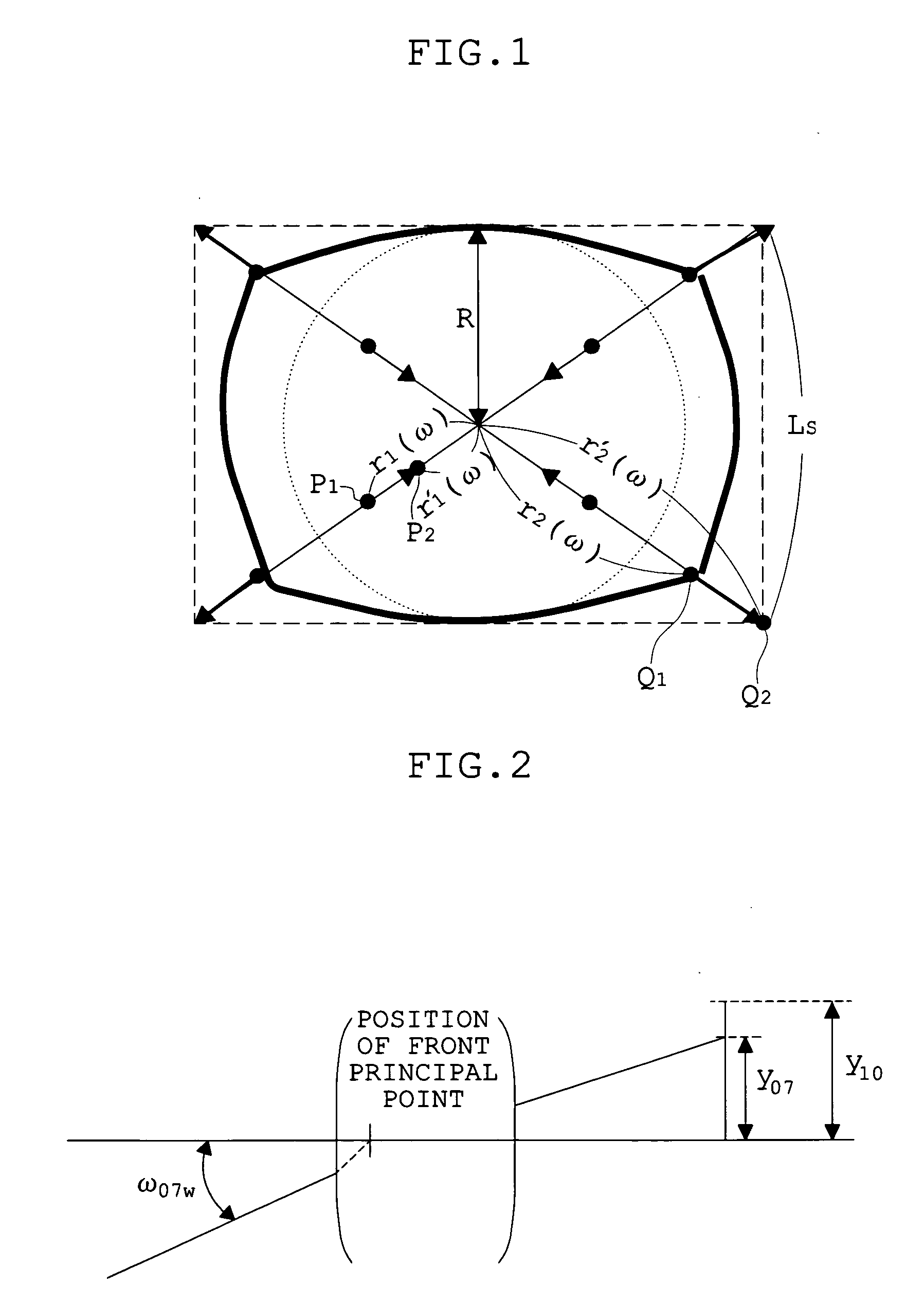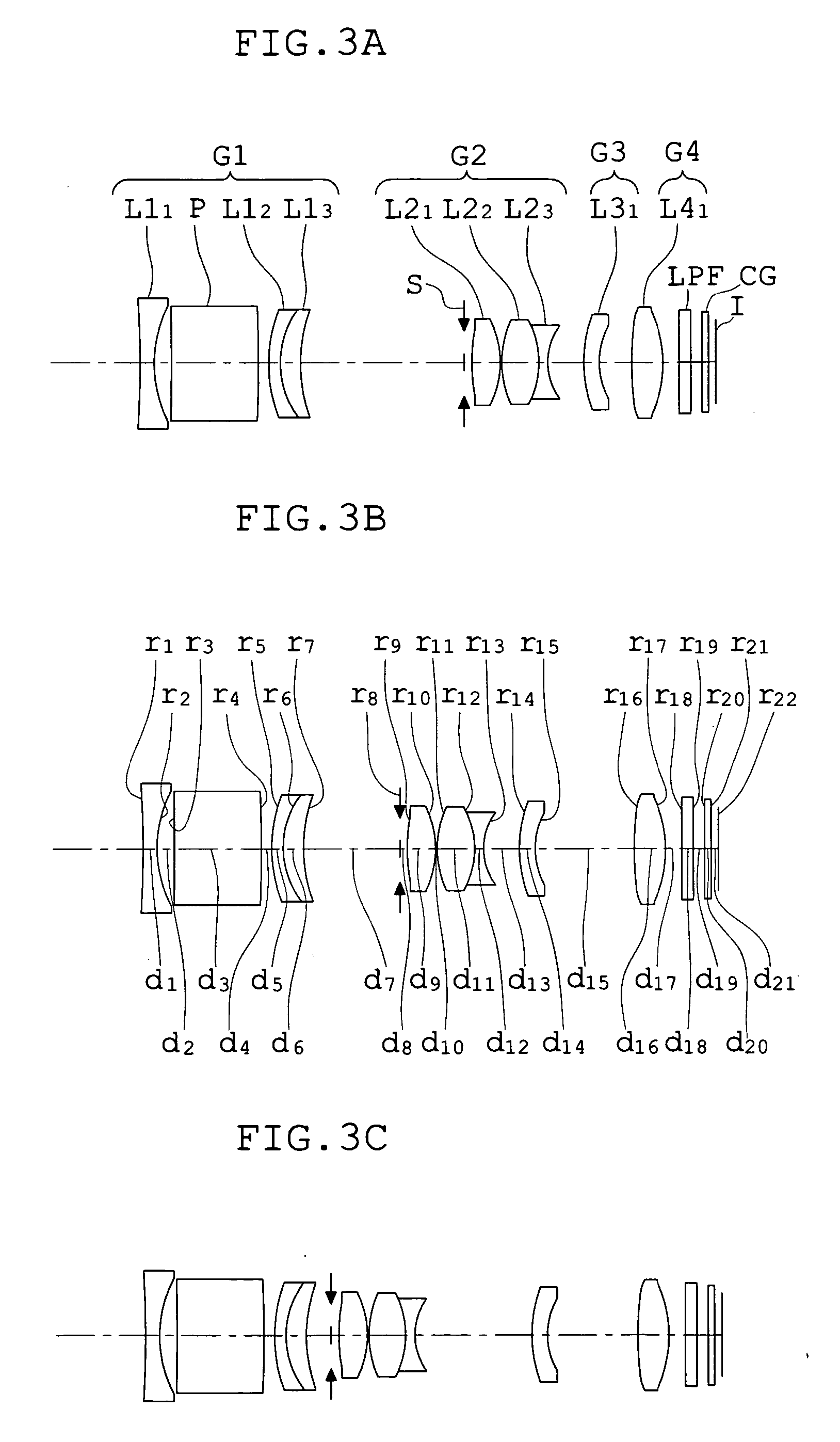Electronic imaging apparatus
a technology of electronic imaging and zoom lens, which is applied in the direction of lenses, instruments, television systems, etc., can solve the problem of optical system thickness, which is an obstacle to a reduction in the depth of the camera, and achieves the effect of reducing the thickness of the optical system
- Summary
- Abstract
- Description
- Claims
- Application Information
AI Technical Summary
Problems solved by technology
Method used
Image
Examples
first embodiment
[0113]FIGS. 3A-3C show lens arrangements of the first embodiment of the zoom optical system according to the present invention. FIGS. 4A-4R show aberration characteristics of the zoom optical system in the first embodiment.
[0114] A four-lens-unit zoom optical system of the first embodiment comprises, in order from the object side, a first lens unit G1 with negative power, an aperture stop S, a second lens unit G2 with positive power, a third lens unit G3 with negative power, and a fourth lens unit G4 with positive power. Reference symbol LPF denotes an optical low-pass filter, CG denotes a cover glass, and I denotes the imaging surface of an electronic image sensor such as a CCD.
[0115] The first lens unit G1 with negative power includes, in order from the object side, a first lens L11 with negative power, an optical path-bending prism P, and a cemented lens of a second lens L12 with negative power and a third lens L13 with positive power. The first lens L1I with negative power is ...
second embodiment
[0123]FIGS. 5A-5C show lens arrangements of the second embodiment of the zoom optical system according to the present invention. FIGS. 6A-6R show aberration characteristics of the zoom optical system in the second embodiment.
[0124] A four-lens-unit zoom optical system of the second embodiment comprises, in order from the object side, a first lens unit G1 with negative power, an aperture stop S, a second lens unit G2 with positive power, a third lens unit G3 with negative power, and a fourth lens unit G4 with positive power. Again, reference symbol LPF denotes an optical low-pass filter, CG denotes a cover glass, and I denotes the imaging surface of an electronic image sensor such as a CCD.
[0125] The first lens unit G1 with negative power includes, in order from the object side, a first lens L11 with negative power, an optical path-bending prism P, and a cemented lens of a second lens L12 with negative power and a third lens L13 with positive power. The first lens L11 with negative...
third embodiment
[0131]FIGS. 7A-7C show lens arrangements of the third embodiment of the zoom optical system according to the present invention. FIGS. 8A-8R show aberration characteristics of the zoom optical system in the third embodiment.
[0132] A two-lens-unit zoom optical system of the third embodiment comprises, in order from the object side, a first lens unit G1 with negative power, an aperture stop S, and a second lens unit G2 with positive power. Again, reference symbol LPF denotes an optical low-pass filter, CG denotes a cover glass, and I denotes the imaging surface of an electronic image sensor such as a CCD.
[0133] The first lens unit G1 with negative power includes, in order from the object side, a first lens L11 with negative power and a second lens L12 with positive power. The first lens L11 with negative power is a biconcave lens whose image-side surface is aspherical. The second lens L12 with positive power is a meniscus lens with a convex surface facing the object side.
[0134] The ...
PUM
 Login to View More
Login to View More Abstract
Description
Claims
Application Information
 Login to View More
Login to View More - R&D
- Intellectual Property
- Life Sciences
- Materials
- Tech Scout
- Unparalleled Data Quality
- Higher Quality Content
- 60% Fewer Hallucinations
Browse by: Latest US Patents, China's latest patents, Technical Efficacy Thesaurus, Application Domain, Technology Topic, Popular Technical Reports.
© 2025 PatSnap. All rights reserved.Legal|Privacy policy|Modern Slavery Act Transparency Statement|Sitemap|About US| Contact US: help@patsnap.com



